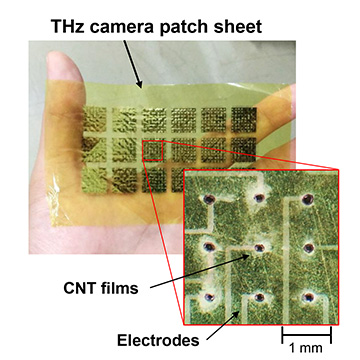
A close up of the THz camera patch sheet shows the free-standing carbon nanotube (CNT) film arrays. [Image: Courtesy of the researchers]
Imagine stick-on cameras that can see inside tubing or monitor structures like bridges for weak points and needed repairs. That is the vision of some researchers for terahertz (THz) imaging, which could potentially transform nondestructive inspection and quality control in factories and other industrial settings.
Now, researchers in Japan have moved a step closer to that vision. They have demonstrated an adjustable process using carbon nanotubes (CNTs) to create a flexible film sensor array that can be applied to a THz video-camera patch sheet (Adv. Func. Mater. doi: 10.1002/adfm.202008931).
Stick-on cameras
The unique imaging capabilities of the terahertz portion of the spectrum, including high-penetration and spatial resolution, surpasses that of ultrasound, infrared, Raman spectroscopy and even X-rays. Unfortunately, existing THz imaging devices—cameras based on 2D THz detector arrays like bolometers and Schottky barrier diodes—are typically flat and rigid. These limitations restrict shapes and locations to be examined, or result in untenable blind spots.
The patch designed by the Japanese team, says lead author Yukio Kawano, an associate professor of electrical engineering at Tokyo Institute of Technology, can be applied to flat or curved surfaces in any shape or size. For example, he says, these 2D arrays can monitor degradation of adhesives, or they could be applied to the exterior of round pipes to accurately detect clogs.
With the new devices, “we have achieved both active scanning using a multiplier or gas laser as an external light source, and passive scanning using radiation from the measurement target as the light source,” Kawano says. “The THz image is rendered by reading the open-circuit voltage of each element and merging all signals in software.”
Secret ingredient: CNTs
Carbon nanotubes (CNTs) are key to the team’s approach, Kawano says. His lab has used the abundant material in previous work to develop other types of flexible sensors and scanners. “The mechanical flexibility of CNT film and its high conversion ability to output optical signals as electrical signals made it an excellent material for flexible cameras.”
To make the 2D film arrays, the team starts with a polyimide film patterned with slits made by a laser. The film is placed on a membrane filter, and a CNT solution selectively filters through the pattern with the aid of a vacuum. The pixel size, Kawano says, can be changed freely depending on the coating conditions and target wavelength.
“We can freely design the size, array pattern, substrate film and suspended shape to match its application based on the simple adjustment of the filtering condition,” the authors write.
No-hassle, metal-evaporation diodes
![]()
The camera patch can be easily cut by scissors and pasted on the fingertips for wearable and portable use. [Image: Courtesy of the researchers]
Using a simple metal-evaporation process, the team was reportedly able to form electrodes on the front and rear sides of the film, completing an easy fabrication of the 2D array.
Kawano notes that CNTs are commercially available and expected to lower in price with wider use, and that the lab’s coating type does not require expensive equipment. What is more, he says, the CNTs do not break when bent, and the lab’s performance tests showed no deterioration under mechanical bending. The patch sheets can reportedly be designed in any size and can be mass produced.
New research directions
“By commercializing the THz camera patch sheets, we aim to create a new breakthrough in the application of multi-view nondestructive testing—without any blind spots—of infrastructure and industrial products,” Kawano says.
The proposed technology, the team writes, has the potential to “create a new research direction on all-around sheet sensors by incorporating THz, thermal, strain and biochemical sensors through the self-aligned filtration process.”
Immediate next steps, Kawano says, would be to improve the uniformity of camera sensitivity and reading speed along with visual reinforcement for inspectors. Kawano says the team also looks to expand use of the flexible camera patch to biomedical applications, such as wearable sensors or sensors in endoscopes.
